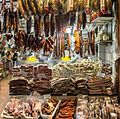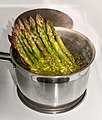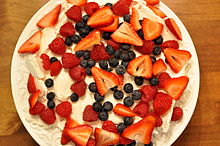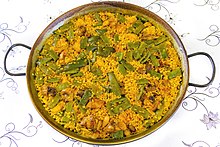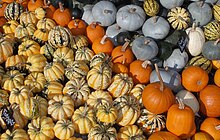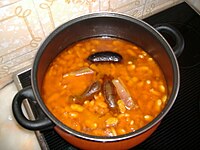Portal:Food
F o o d
A portal dedicated to food and foodways
Introduction
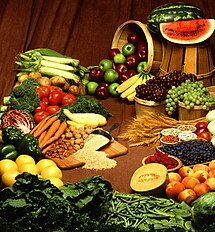
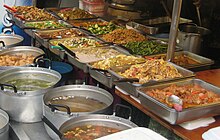
Food is any substance consumed by an organism for nutritional support. Food is usually of plant, animal, or fungal origin and contains essential nutrients such as carbohydrates, fats, proteins, vitamins, or minerals. The substance is ingested by an organism and assimilated by the organism's cells to provide energy, maintain life, or stimulate growth. Different species of animals have different feeding behaviours that satisfy the needs of their metabolisms and have evolved to fill a specific ecological niche within specific geographical contexts.
Omnivorous humans are highly adaptable and have adapted to obtain food in many different ecosystems. Humans generally use cooking to prepare food for consumption. The majority of the food energy required is supplied by the industrial food industry, which produces food through intensive agriculture and distributes it through complex food processing and food distribution systems. This system of conventional agriculture relies heavily on fossil fuels, which means that the food and agricultural systems are one of the major contributors to climate change, accounting for as much as 37% of total greenhouse gas emissions. (Full article...)
Cooking, also known as cookery or professionally as the culinary arts, is the art, science and craft of using heat to make food more palatable, digestible, nutritious, or safe. Cooking techniques and ingredients vary widely, from grilling food over an open fire, to using electric stoves, to baking in various types of ovens, reflecting local conditions. Cooking is an aspect of all human societies and a cultural universal.
Preparing food with heat or fire is an activity unique to humans. Archeological evidence of cooking fires from at least 300,000 years ago exists, but some estimate that humans started cooking up to 2 million years ago.
The expansion of agriculture, commerce, trade, and transportation between civilizations in different regions offered cooks many new ingredients. New inventions and technologies, such as the invention of pottery for holding and boiling of water, expanded cooking techniques. Some modern cooks apply advanced scientific techniques to food preparation to further enhance the flavor of the dish served. (Full article...)
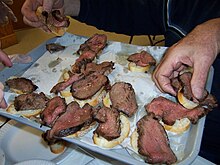
A beefsteak is a type of banquet in which sliced beef tenderloin is served to diners as all-you-can-eat finger food. The dining style originated in 19th-century New York City as a type of working-class celebration but went into a decline in the mid-20th century. Resurrected by caterers in New Jersey, the beefsteak banquet style remained popular in that state's Bergen and Passaic counties, and is enjoying a revival in New York City, where the style originated, due to the reemergence of a biannual beefsteak in Brooklyn. Similar "beef and beer fundraisers" are common in the Philadelphia region, especially in white working class communities. (Full article...)
Selected article –
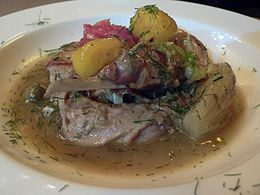
Selected cuisine -
The cuisine of New Zealand is largely driven by local ingredients and seasonal variations. As an island nation with a primarily agricultural economy, New Zealand yields produce from land and sea. Similar to the cuisine of Australia, the cuisine of New Zealand is a diverse British-based cuisine, with Mediterranean and Pacific Rim influences as the country has become more cosmopolitan.
Historical influences came from British cuisine and Māori culture. Since the 1970s, new cuisines such as New American cuisine, Southeast Asian, East Asian, and South Asian have become popular. (Full article...)Selected ingredient –
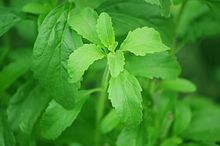
Stevia (/ˈstiːviə, ˈstɛviə/) is a sweet sugar substitute that is about 50 to 300 times sweeter than sugar. It is extracted from the leaves of Stevia rebaudiana, a plant native to areas of Paraguay and Brazil in the southern Amazon rainforest. The active compounds in stevia are steviol glycosides (mainly stevioside and rebaudioside). Stevia is heat-stable, pH-stable, and not fermentable. Humans cannot metabolize the glycosides in stevia, and therefore it has zero calories. Its taste has a slower onset and longer duration than that of sugar, and at high concentrations some of its extracts may have an aftertaste described as licorice-like or bitter. Stevia is used in sugar- and calorie-reduced food and beverage products as an alternative for variants with sugar.
The legal status of stevia as a food additive or dietary supplement varies from country to country. In the United States, certain high-purity stevia glycoside extracts have been generally recognized as safe (GRAS) and may be lawfully marketed and added to food products, but stevia leaf and crude extracts do not have GRAS or Food and Drug Administration (FDA) approval for use in food. The European Union approved Stevia rebaudiana additives in 2011. In Japan, stevia has been widely used as a sweetener for decades. (Full article...)
Selected recipe –
Paella (/paɪˈɛlə/, /pɑːˈeɪjə/, py-EL-ə, pah-AY-yə, Valencian: [paˈeʎa]; Spanish: [paˈeʝa]) is a rice dish originally from the Valencian Community. Paella is regarded as one of the community's identifying symbols. It is one of the best-known dishes in Spanish cuisine.
The dish takes its name from the wide, shallow traditional pan used to cook the dish on an open fire, paella being the word for a frying pan in Valencian language. As a dish, it may have ancient roots, but in its modern form, it is traced back to the mid-19th century, in the rural area around the Albufera lagoon adjacent to the city of Valencia, on the Mediterranean coast of Spain. (Full article...)
Cucurbita (Latin for 'gourd') is a genus of herbaceous fruits in the gourd family, Cucurbitaceae (also known as cucurbits or cucurbi), native to the Andes and Mesoamerica. Five edible species are grown and consumed for their flesh and seeds. They are variously known as squash, pumpkin, or gourd, depending on species, variety, and local parlance. Other kinds of gourd, also called bottle-gourds, are native to Africa and belong to the genus Lagenaria, which is in the same family and subfamily as Cucurbita, but in a different tribe. These other gourds are used as utensils or vessels, and their young fruits are eaten much like those of the Cucurbita species.
Most Cucurbita species are herbaceous vines that grow several meters in length and have tendrils, but non-vining "bush" cultivars of C. pepo and C. maxima have also been developed. The yellow or orange flowers on a Cucurbita plant are of two types: female and male. The female flowers produce the fruit and the male flowers produce pollen. Many North and Central American species are visited by specialist bee pollinators, but other insects with more general feeding habits, such as honey bees, also visit. (Full article...)Selected image –
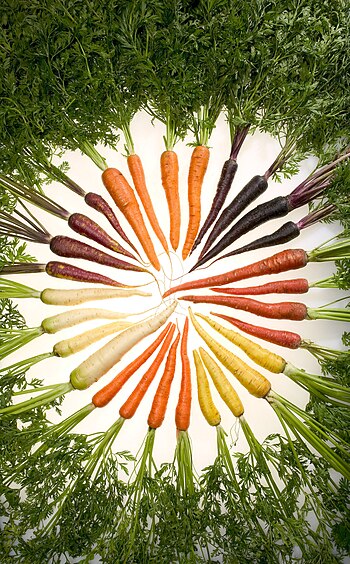
Selected biography –
B. November 8, 1966
Gordon James Ramsay OBE (/ˈræmzi/; born 8 November 1966) is a British celebrity chef, restaurateur, television presenter, and writer. His restaurant group, Gordon Ramsay Restaurants, was founded in 1997 and has been awarded 17 Michelin stars overall and currently holds eight. His signature restaurant, Restaurant Gordon Ramsay in Chelsea, London, has held three Michelin stars since 2001. After rising to fame on the British television miniseries Boiling Point in 1999, Ramsay became one of the best-known and most influential chefs in the world.
Ramsay's TV persona is defined by his fiery temper, aggressive behaviour, strict demeanour, and frequent usage of profane language, while making blunt, critical, and controversial comments, including insults and sardonic wisecracks about contestants and their cooking abilities. He combines activities in the television, film, hospitality and food industries, and has promoted and hired various chefs who have apprenticed under his wing. He is known for presenting television programmes about competitive cookery and food, such as the British series Hell's Kitchen (2004), Ramsay's Kitchen Nightmares (2004–2009, 2014), and The F Word (2005–2010), with Kitchen Nightmares winning the 2005 British Academy Television Award for Best Feature, and the American versions of Hell's Kitchen (2005–present), Kitchen Nightmares (2007–present), MasterChef (2010–present), and MasterChef Junior (2013–present), as well as Hotel Hell (2012–2016), Gordon Behind Bars (2012), Gordon Ramsay's 24 Hours to Hell and Back (2018–2020), and Next Level Chef (2022–present). (Full article...)
Did you know (auto-generated) –

- ... that the fork-tailed drongo gives genuine alarm calls but will sometimes lie to steal food from other animals?
- ... that the reactions to food depicted in the manga series Food Wars!: Shokugeki no Soma were decided on through free association games?
- ... that New Zealand editor and journalist Madeleine Chapman, known for fashion label exposés and snack food ranking lists, is a champion javelin thrower?
- ... that the Unitized Group Ration – Express is designed to heat food itself without the need of a field kitchen?
- ... that food was left to rot outside after the supermarket Supie went out of business?
- ... that food critic Grace Dent reviewed a Liverpool restaurant that served her rice pudding flavoured with a substance that is banned in the United States for its lethality?
More did you know –
Related portals
Food topics
The following are topics relating to food
Categories
Food list articles
- See also: Lists of foods and Category:Lists of drinks
The following are some Food list articles on Wikipedia:

- American cheeses
- Appellation d'Origine Contrôlée cheeses
- Apple cultivars
- Bacon dishes
- Bacon substitutes
- Basil cultivars
- Breads
- Breakfast beverages
- Breakfast cereals
- Breakfast foods
- British cheeses
- Cakes
- Candies
- Cheeses
- Cheese soups
- Christmas dishes (list)
- Cocktails
- Cookies
- Dishes using coconut milk
- Diets
- Doughnut varieties
- Egg dishes
- Fermented soy products
- Food additives
- Food additives (Codex Alimentarius)
- Foods named after people
- French cheeses
- French dishes
- Fried dough foods
- Fruits
- List of hamburgers
- Herbs and spices
- Hors d'oeuvre
- Indian dishes
- Indian snack foods
- Indonesian dishes
- Italian dishes
- Japanese snacks
- Japanese dishes
- Jewish dishes
- Kebabs
- Korean beverages
- Mango cultivars
- Moroccan dishes
- Pasta
- Pastries
- Philippine snack food
- Pies, tarts and flans
- Poppy seed pastries and dishes
- Potato dishes
- Puddings
- Raw fish dishes
- Rice dishes
- Rolled foods
- Sauces
- Seafood
- Seeds
- Sandwiches
- Snack foods
- Soft drinks by country
- Soul foods and dishes
- Soups
- Stews
- Street foods
- Tapas
- Turkish dishes
- Twice-baked foods
- Vegetable oils
- Vegetables
- Vodkas
Things you can do
Related WikiProjects
| Parent project: WikiProject Food and Drink | |
| Child projects: | Task forces: (All inactive) |
|
|
| Related projects: | |
New articles
Rules | Match log | Results page (for watching) | Last updated: 2024-05-22 19:50 (UTC)
Note: The list display can now be customized by each user. See List display personalization for details.
- Virginia Sole-Smith (edit | talk | history | links | watch | logs | tools) by Marquardtika (talk · contribs · new pages (1)) started on 2024-05-22, score: 10
- Lohusa şerbeti (edit | talk | history | links | watch | logs | tools) by Macrakis (talk · contribs · new pages (3)) started on 2024-05-22, score: 30
- I, the Executioner (edit | talk | history | links | watch | logs | tools) by Οἶδα (talk · contribs · new pages (16)) started on 2024-05-21, score: 10
- Paul Parkman (edit | talk | history | links | watch | logs | tools) by Thriley (talk · contribs · new pages (42)) started on 2024-05-21, score: 10
- Two Roosters Ice Cream (edit | talk | history | links | watch | logs | tools) by Johnson524 (talk · contribs · new pages (2)) started on 2024-05-21, score: 10
- There Be Monsters (edit | talk | history | links | watch | logs | tools) by Another Believer (talk · contribs · new pages (99)) started on 2024-05-21, score: 10
- Chinir saaj (edit | talk | history | links | watch | logs | tools) by Moriwen (talk · contribs · new pages (280)) started on 2024-05-21, score: 30
- Doogh (edit | talk | history | links | watch | logs | tools) by MuhammedBenShalom (talk · contribs · new pages (1)) started on 2024-05-21, score: 20
- Sata physic gardens (edit | talk | history | links | watch | logs | tools) by MChew (talk · contribs · new pages (12)) started on 2024-05-21, score: 10
- Nam Dae-sik (edit | talk | history | links | watch | logs | tools) by Das osmnezz (talk · contribs · new pages (57)) started on 2024-05-20, score: 10
- Le Chique (edit | talk | history | links | watch | logs | tools) by Another Believer (talk · contribs · new pages (99)) started on 2024-05-20, score: 10
- Khanom met khanun (edit | talk | history | links | watch | logs | tools) by Quantplinus (talk · contribs · new pages (1)) started on 2024-05-18, score: 10
- Pao Alentejano (edit | talk | history | links | watch | logs | tools) by Valereee (talk · contribs · new pages (12)) started on 2024-05-20, score: 10
- Sir Grapefellow and Baron von Redberry (edit | talk | history | links | watch | logs | tools) by Retrosunshine2006 (talk · contribs · new pages (1)) started on 2024-05-20, score: 20
- Pharasmanes II (edit | talk | history | links | watch | logs | tools) by BilledMammal (talk · contribs · new pages (151)) started on 2024-05-19, score: 10
- Kinamatisang manok (edit | talk | history | links | watch | logs | tools) by Obsidian Soul (talk · contribs · new pages (8)) started on 2024-05-19, score: 10
- Federal Food, Drug, and Cosmetic Act of 1938 (edit | talk | history | links | watch | logs | tools) by Irruptive Creditor (talk · contribs · new pages (1)) started on 2024-05-19, score: 10
- IT'SUGAR (edit | talk | history | links | watch | logs | tools) by AbsentPat (talk · contribs · new pages (2)) started on 2024-05-19, score: 20
- Harvey's Butter Rum Batter (edit | talk | history | links | watch | logs | tools) by AbsentPat (talk · contribs · new pages (2)) started on 2024-05-19, score: 20
- Mar-Jac Poultry (edit | talk | history | links | watch | logs | tools) by TJMSmith (talk · contribs · new pages (16)) started on 2024-05-18, score: 10
- Festival del Sole (edit | talk | history | links | watch | logs | tools) by 87.74.175.29 (talk · contribs · new pages (2)) started on 2024-05-18, score: 20
- Chew: Major League Chew (edit | talk | history | links | watch | logs | tools) by Born in the maw of dug (talk · contribs · new pages (7)) started on 2024-05-08, score: 10
- Chew: International Flavor (edit | talk | history | links | watch | logs | tools) by IzzyBell Oskverry (talk · contribs · new pages (1)) started on 2024-05-07, score: 10
- Joyride Sweets (edit | talk | history | links | watch | logs | tools) by Bennett1203 (talk · contribs · new pages (14)) started on 2024-05-18, score: 40
- Khanom Med Khanoon (edit | talk | history | links | watch | logs | tools) by Quantplinus (talk · contribs · new pages (1)) started on 2024-05-18, score: 10
- Tony Connor (musician) (edit | talk | history | links | watch | logs | tools) by Anavatar (talk · contribs · new pages (6)) started on 2024-05-18, score: 10
- Patrick Olive (edit | talk | history | links | watch | logs | tools) by Anavatar (talk · contribs · new pages (6)) started on 2024-05-18, score: 10
- Taquería El Califa de León (edit | talk | history | links | watch | logs | tools) by Tbhotch (talk · contribs · new pages (28)) started on 2024-05-18, score: 10
- Harvey Hinsley (edit | talk | history | links | watch | logs | tools) by Anavatar (talk · contribs · new pages (6)) started on 2024-05-17, score: 10
- Fulcrum Coffee (edit | talk | history | links | watch | logs | tools) by Another Believer (talk · contribs · new pages (99)) started on 2024-05-17, score: 10
- Kutach (edit | talk | history | links | watch | logs | tools) by PiMaster3 (talk · contribs · new pages (3)) started on 2024-05-16, score: 20
- White Rhino Coffee (edit | talk | history | links | watch | logs | tools) by Blizzleduh (talk · contribs · new pages (1)) started on 2024-05-15, score: 10
- On2Cook (edit | talk | history | links | watch | logs | tools) by Roadrazer84 (talk · contribs · new pages (1)) started on 2024-05-15, score: 10
- MDH and Everest global safety concerns (edit | talk | history | links | watch | logs | tools) by Sherenk1 (talk · contribs · new pages (1)) started on 2024-05-15, score: 20
- Domoda (edit | talk | history | links | watch | logs | tools) by Monomi0 (talk · contribs · new pages (1)) started on 2024-05-14, score: 10
- Egg Yolkeo (edit | talk | history | links | watch | logs | tools) by A.S. Brown (talk · contribs · new pages (8)) started on 2024-05-11, score: 20
- Magical Golden Singing Cheeses (edit | talk | history | links | watch | logs | tools) by A.S. Brown (talk · contribs · new pages (8)) started on 2024-05-11, score: 10
- Kōji (food) (edit | talk | history | links | watch | logs | tools) by Ghilt (talk · contribs · new pages (4)) started on 2024-05-13, score: 10
- Koji (food) (edit | talk | history | links | watch | logs | tools) by Ghilt (talk · contribs · new pages (4)) started on 2024-05-13, score: 10
- Half and Half Doughnut Co. (edit | talk | history | links | watch | logs | tools) by Another Believer (talk · contribs · new pages (99)) started on 2024-05-13, score: 10
- Williams and Woods (edit | talk | history | links | watch | logs | tools) by GeneralBelly (talk · contribs · new pages (3)) started on 2024-05-12, score: 10
- Thamnaconus hypargyreus (edit | talk | history | links | watch | logs | tools) by Primium (talk · contribs · new pages (12)) started on 2024-05-12, score: 10
- Akbar Mirza Khaleeli (edit | talk | history | links | watch | logs | tools) by Bingchungus (talk · contribs · new pages (2)) started on 2024-05-12, score: 10
- Garry Kennebrew (edit | talk | history | links | watch | logs | tools) by AllWeKnowOfHeaven (talk · contribs · new pages (2)) started on 2024-05-06, score: 10
- Demonstration kitchen (edit | talk | history | links | watch | logs | tools) by Whoisjohngalt (talk · contribs · new pages (2)) started on 2024-05-12, score: 20
- China in Box (edit | talk | history | links | watch | logs | tools) by Vitorperrut555 (talk · contribs · new pages (1)) started on 2024-05-12, score: 20
- Chinatown Ice Cream Factory (edit | talk | history | links | watch | logs | tools) by ForsythiaJo (talk · contribs · new pages (90)) started on 2024-05-11, score: 10
- Pepsi AM (edit | talk | history | links | watch | logs | tools) by Tatsnorad (talk · contribs · new pages (3)) started on 2024-05-11, score: 20
- South Bend Chocolate Company (edit | talk | history | links | watch | logs | tools) by CusterDome (talk · contribs · new pages (1)) started on 2024-05-11, score: 10
- Hey Chicken! (edit | talk | history | links | watch | logs | tools) by Luvcraft (talk · contribs · new pages (1)) started on 2024-05-11, score: 10
- Ko Omm (edit | talk | history | links | watch | logs | tools) by Sattwaikyaw (talk · contribs · new pages (1)) started on 2024-05-11, score: 10
- Soumaintrain (cheese) (edit | talk | history | links | watch | logs | tools) by WillBanz (talk · contribs · new pages (1)) started on 2024-05-11, score: 20
- SugarBun (edit | talk | history | links | watch | logs | tools) by The Bangsawan (talk · contribs · new pages (5)) started on 2024-05-11, score: 10
- List of whisky brands in England (edit | talk | history | links | watch | logs | tools) by ChefBear01 (talk · contribs · new pages (4)) started on 2024-05-10, score: 20
- Donut Factory (edit | talk | history | links | watch | logs | tools) by Another Believer (talk · contribs · new pages (99)) started on 2024-05-10, score: 10
- Causa (restaurant) (edit | talk | history | links | watch | logs | tools) by Another Believer (talk · contribs · new pages (99)) started on 2024-05-10, score: 10
- Rania (restaurant) (edit | talk | history | links | watch | logs | tools) by Another Believer (talk · contribs · new pages (99)) started on 2024-05-10, score: 10
- Adams Oyster Company (edit | talk | history | links | watch | logs | tools) by DMVHistorian (talk · contribs · new pages (12)) started on 2024-05-10, score: 10
- Spaghetti alla siracusana (edit | talk | history | links | watch | logs | tools) by JackkBrown (talk · contribs · new pages (3)) started on 2024-05-09, score: 10
- Puffed rice cakes (edit | talk | history | links | watch | logs | tools) by 2003:CA:8718:D68F:4AEE:DFFA:5B34:E259 (talk · contribs · new pages (1)) started on 2024-05-09, score: 30
- Osmotherium (edit | talk | history | links | watch | logs | tools) by LaraPoasting (talk · contribs · new pages (4)) started on 2024-05-09, score: 10
- Fresh Thyme (edit | talk | history | links | watch | logs | tools) by 96.69.249.93 (talk · contribs · new pages (2)) started on 2024-05-09, score: 10
- Chicago Steak Company (edit | talk | history | links | watch | logs | tools) by AbrilTheCarpenter (talk · contribs · new pages (2)) started on 2024-05-09, score: 20
Associated Wikimedia
The following Wikimedia Foundation sister projects provide more on this subject:
-
Commons
Free media repository -
Wikibooks
Free textbooks and manuals -
Wikidata
Free knowledge base -
Wikinews
Free-content news -
Wikiquote
Collection of quotations -
Wikisource
Free-content library -
Wikiversity
Free learning tools -
Wiktionary
Dictionary and thesaurus









